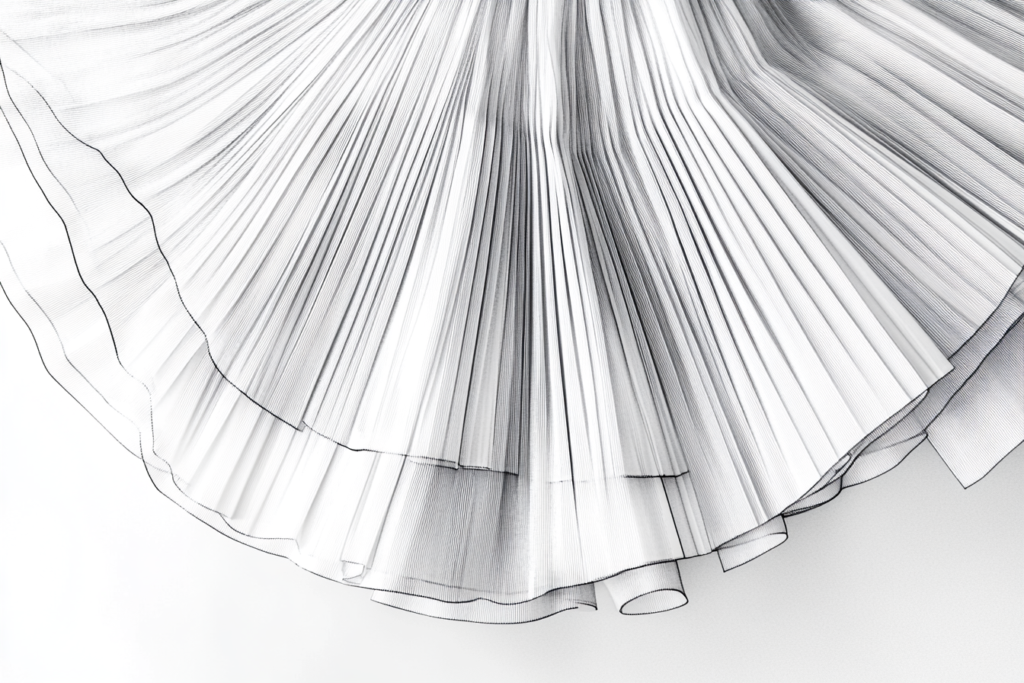Pleat Depth: The Key Measurement in Pleated Fabric Design
Meta Description: Pleat depth refers to the distance between the outermost and innermost sides of a pleat. Learn how it affects fabric volume, structure, and garment design.
What is Pleat Depth?
Pleat depth is the measurement from the outermost edge to the innermost fold of a pleat, determining how much fabric is used and how pronounced the pleat appears. It is an essential factor in pleated skirts, trousers, dresses, and decorative fabric designs, influencing the fullness and drape of a garment.
Pleat depth is often used in pattern making and garment construction to achieve structured, voluminous, or subtle pleating effects.


Key Features of Pleat Depth
✔ Measures the Fabric Fold Distance – From the outermost to innermost side of a pleat.
✔ Controls Volume & Structure – Deeper pleats create more fullness, while shallow pleats appear subtle.
✔ Impacts Fabric Consumption – Deeper pleats require more fabric to maintain their shape.
✔ Used in Various Pleating Styles – Affects knife pleats, box pleats, accordion pleats, and more.
✔ Essential for Tailoring & Pattern Making – Ensures consistent pleat formation in garments.
Where is Pleat Depth Used in Fashion?
📌 Pleated Skirts & Dresses – Determines flow and volume.
📌 Trousers & Formal Pants – Affects waist shaping and structure.
📌 School & Uniform Skirts – Maintains a crisp, structured look.
📌 Couture & High-Fashion Designs – Used for dramatic, exaggerated pleating effects.
📌 Interior & Textile Design – Seen in drapes, upholstery, and decorative fabrics.
Types of Pleats & How Pleat Depth Affects Them
1. Knife Pleats
- Pleat depth: Shallow to medium
- Creates a uniform, sleek appearance.
- Common in skirts, kilts, and school uniforms.
2. Box Pleats
- Pleat depth: Moderate to deep
- Produces a voluminous, structured effect.
- Seen in classic skirts, jackets, and dresses.
3. Accordion Pleats
- Pleat depth: Shallow to moderate
- Forms a zigzag pattern with evenly spaced folds.
- Adds soft movement to flowing fabrics.
4. Sunburst Pleats
- Pleat depth: Variable (narrow at the top, wider at the hem)
- Creates a flared, dynamic silhouette.
- Found in gowns and formal evening wear.
5. Inverted Pleats
- Pleat depth: Moderate to deep
- Folds inward, hiding the fullness until movement reveals it.
- Common in skirts and dresses for subtle volume.
💡 Tip: The deeper the pleat, the more structured and voluminous the garment will appear.
Pleat Depth vs. Other Pleat Measurements
| Measurement | Definition | Effect on Garment |
|---|---|---|
| Pleat Depth | Distance from outermost to innermost fold | Controls volume and fullness |
| Pleat Spacing | Distance between pleats | Affects fabric flow and appearance |
| Pleat Width | Total width of the pleat, including folds | Determines pleat size and prominence |
| Pleat Overlap | How much fabric layers over itself in a pleat | Impacts structure and drape |
💡 Tip: Deep pleats use more fabric but provide greater definition and movement.
How to Choose the Right Pleat Depth for Your Garment
✔ For Structured Looks → Use deep pleats (e.g., box pleats in tailored skirts).
✔ For Soft, Flowing Drapes → Opt for shallow pleats (e.g., accordion pleats in chiffon gowns).
✔ For Formal & Professional Wear → Choose moderate pleats (e.g., knife pleats in trousers).
✔ For High-Fashion Statements → Experiment with varying pleat depths (e.g., sunburst pleats in couture dresses).
💡 Tip: Deep pleats create volume, while shallow pleats maintain a sleek, refined look.
Why Is Pleat Depth Important?
✔ Defines Garment Structure – Controls how pleats appear and move.
✔ Affects Fabric Consumption – Deeper pleats require more material.
✔ Determines Overall Fit & Silhouette – Helps achieve tailored or flowy designs.
✔ Enhances Styling Versatility – Used in both casual and formal fashion.
✔ Essential for Proper Pleating Techniques – Ensures pleats hold their shape correctly.
Conclusion: The Role of Pleat Depth in Fashion Design
Pleat depth is a fundamental measurement in garment construction, influencing the volume, drape, and structure of pleated designs. Whether in skirts, trousers, or couture fashion, understanding pleat depth helps create visually stunning and well-balanced garments.
For designers and tailors, mastering pleat depth allows precise control over how pleats behave, ensuring both aesthetic appeal and functional comfort.



